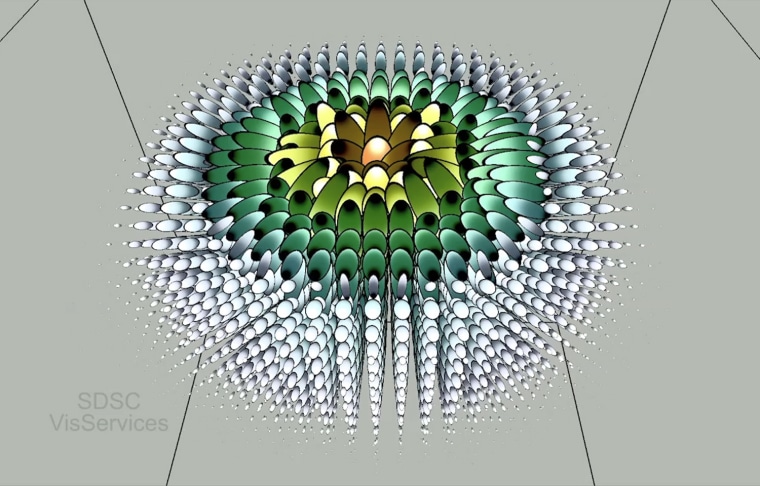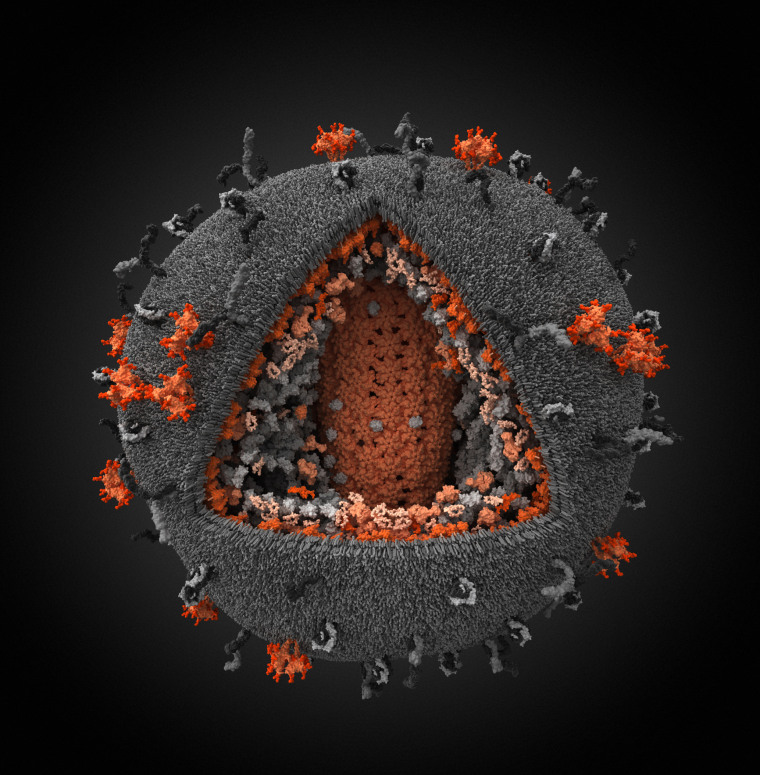Talk about going viral: The honorees in one of the world's most respected competitions for scientific visualization include views of some nasty-looking viruses, plus a host of videos that deserve to get some viral distribution. Take a look at the top of the crop in the 2010 International Science and Engineering Visualization Challenge, jointly sponsored by the journal Science and the National Science Foundation.
The visualization contest, which is currently in its eighth year, recognizes scientists and artists who use visual media to promote understanding of scientific research. The criteria for judging the entries include visual impact, effective communication, freshness and originality.
This year's first-place winner in the illustration category is a 3-D representation of an HIV virus, rendered in unprecedented detail.
"We consider such 3-D models as a new way to present and promote scientific data about ubiquitous human viruses," Ivan Konstantinov of the Visual Science Company said in today's announcement of the contest results. Konstantinov said he and his colleagues tried to show the viral particle as realistically as possible.
"While working on the HIV model, over 100 articles from leading scientific journals were analyzed," he said. "For this project, Dr. Yegor Voronin from the Global HIV Vaccine Enterprise helped us evaluate the data, shared recent findings and views in the field, and provided general advice." Konstantinov said 3-D scientific modeling may have applications for the Web, for tablets and other mobile devices.
The first-place winner in the non-interactive media category used video to tell the story of 3,000 pieces of trash from Seattle that were tagged with sensors and tracked as they made their way through the nation's garbage disposal system.
"Our project aims to reveal the disposal process of our everyday objects, as well as to highlight potential inefficiencies in today's recycling and sanitation systems," Carlo Ratti, director of the "Trash | Track" video project from SENSEable City Lab at MIT, said in today's announcement.
"It was fascinating to see this invisible infrastructure unfold," said Dietmar Offenhuber, the project's team leader. "The extent and the complexity of the network of waste trajectories were quite unexpected."
The visualization challenge and similar roundups of scientific imagery such as Nikon's Small World contest and Olympus' BioScapes competition give a much-needed boost to public interest in science. It's easy to get sucked in by the science-fictiony pictures — and learn some science facts in the process.
Check out our slideshow, and explore the online showcases offered by Science as well as the National Science Foundation. Here's the full list of winners, followed by links to some more visual (and justifiably viral) treats.
Photography
First Place:
Seth B. Darling and Steven J. Sibener; Argonne National Laboratory and the University of Chicago
Rough Waters
Honorable Mentions (tie):
Robert Rock Belliveau M.D.
Trichomes (hairs) on the Seed of the Common Tomato (Solanum lycopersicum)
Katie L. Hoffman and Robert J. Wood; Harvard University
Centipede Millirobot
Illustrations
First Place: Ivan Konstantinov, Yury Stefanov, Aleksander Kovalevsky, and Yegor Voronin; Visual Science Company
Human Immunodeficiency Virus, 3D model
Honorable Mentions (3-way tie):
Insuk Lee, Michael Ahn, Edward Marcotte and Seung Yon Rhee; Carnegie Institution for Science, Department of Plant Biology
AraNet: A genome-wide gene function association network for Arabidopsis thaliana
Russell M. Taylor II, Andrew Stephens, Kerry Bloom, Leandra Vicci, Jolien Verdaasdonk, Steven Nedrud, Matt Larson, and Mike Falvo; the University of North Carolina at Chapel Hill
Proposed Structure of the Yeast Mitotic Spindle
Dr. Jonathan Heras; Equinox Graphics Ltd.
Enterobacteria Phage T4
Informational graphics
First Place:
Kandis Elliot and Mo Fayyaz; University of Wisconsin-Department of Botany
Honorable Mention:
Peter Crnokrak; The Luxury of Protest
Non-interactive media
First Place:
Dietmar Offenhuber, E. Roon Kang, Carnaven Chiu, Armin Linke, Assaf Biderman, Carlo Ratti; Senseable city lab / MIT, supported by Waste Management, Qualcomm, Sprint, and the Architectural League NY
Trash | Track (project described in the video below):
Honorable Mentions (4-way tie):
Drew Berry, Mark Ellisman, François Tétaz; The Walter and Eliza Hall Institute of Medical Research
Visualization of the Whole Brain Catalog (see below):
Thomas J. Cox; Observatories of the Carnegie Institution
A Binary Quasar Caught in the Act of Merging (see below):
Amit Chourasia, Emmett Mcquinn, Bernard Minster, Jurgen Schulze; San Diego Supercomputer Center, UCSD
GlyphSea (video explanation linked below):

Damian Pope, Greg Dick, Sean Bradley, Dave Fish, Roberta Tevlin, Steve Kelly, and Tim Langford; Perimeter Institute for Theoretical Physics
Everyday Einstein: GPS and Relativity (video highlights below):
More scientific visions to enjoy:
- Top sights of science: 2009's winners
- Science you can see: 2008's winners
- Science's best sights: 2007's winners
- More visions of science: 2006's winners
- Visualization challenge: 2005's winners
- A scientific visual feast: 2004's winners
- Visualization challenge: 2003's winners
- Olympus BioScapes winners from 2010
- Beauty in a bug's heart: Nikon Small World 2010
Join the Cosmic Log community by clicking the "like" button on our Facebook page or by following msnbc.com science editor Alan Boyle as b0yle on Twitter. To learn more about Alan Boyle's book on Pluto and the search for planets, check out the website for "The Case for Pluto."
